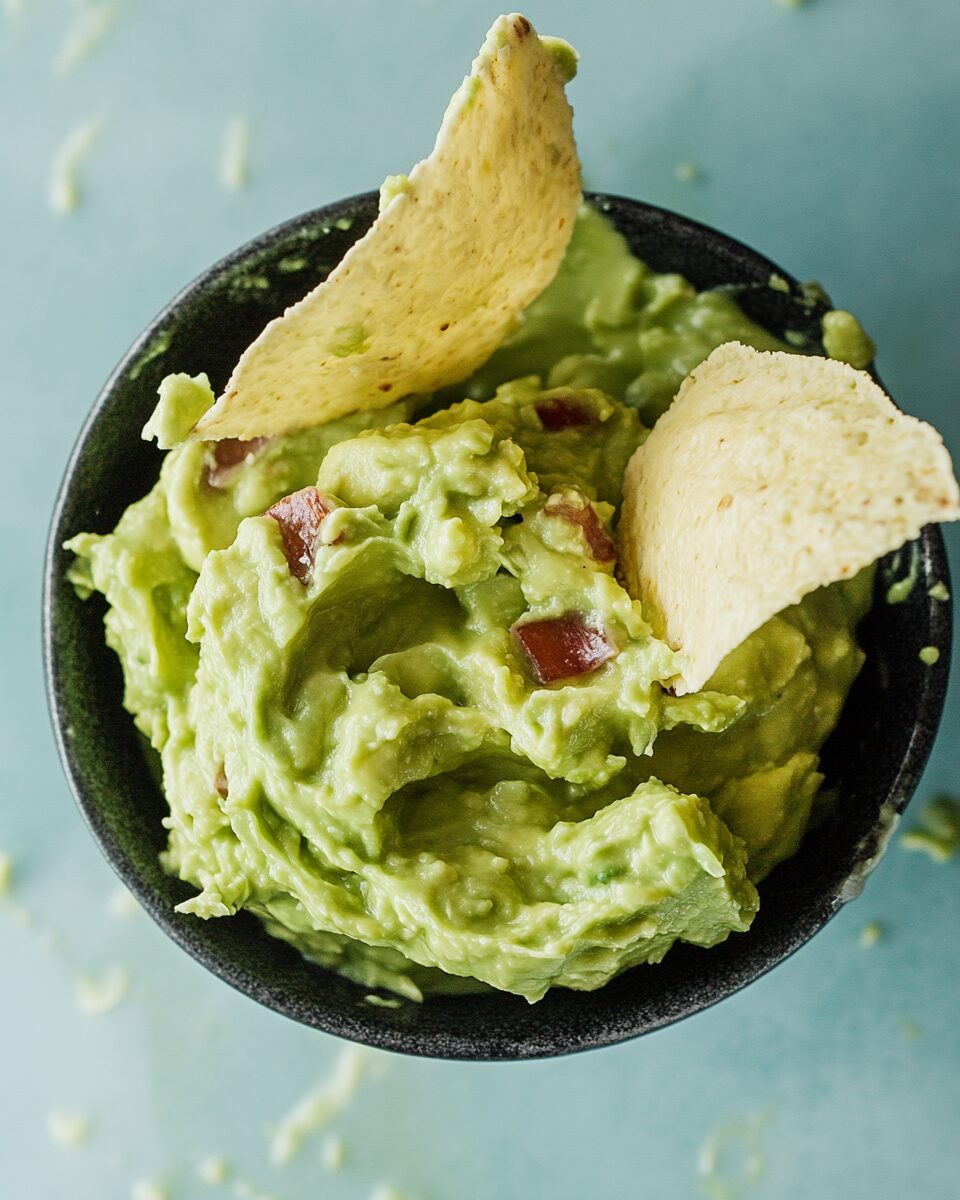This creamy and flavorful guacamole is the perfect blend of ripe avocados, zesty lime juice, and fresh herbs. It’s a must-have dip for any party, taco night, or as a topping for your favorite dishes. Simple, fresh, and ready in minutes, this guacamole is sure to become your go-to recipe.
FULL RECIPE
Ingredients
- 3 ripe avocados
- 1 lime, juiced
- ½ teaspoon salt
- ½ cup diced red onion
- 3 tablespoons chopped fresh cilantro
- 2 roma tomatoes, diced
- 1 teaspoon minced garlic
- 1 pinch ground cayenne pepper (optional)
Directions
- Cut the avocados in half, remove the pits, and scoop the flesh into a mixing bowl.
- Add lime juice and salt. Mash with a fork or potato masher to desired consistency.
- Stir in diced red onion, chopped cilantro, tomatoes, and minced garlic.
- Add cayenne pepper if you like a bit of heat.
- Taste and adjust seasoning as needed.
- Serve immediately, or cover tightly with plastic wrap pressed onto the surface to prevent browning.
Nutritional Information
- Calories: 90
- Fat: 8g
- Saturated Fat: 1g
- Carbohydrates: 5g
- Fiber: 3g
- Sugars: 1g
- Protein: 1g
- Sodium: 150mg
The Role of Avocados in a Balanced Diet
Avocados, the star ingredient in guacamole, are unique among fruits because they are high in healthy fats. These fats can help lower bad cholesterol levels when consumed in moderation. Their creamy texture makes them ideal for creating smooth dips and spreads, contributing to a satisfying, nutrient-dense diet.
Why Guacamole is a Heart-Healthy Snack
The high levels of potassium and monounsaturated fats in guacamole help reduce blood pressure and improve cholesterol levels. These elements contribute to better heart function and lower the risk of cardiovascular disease, making guacamole a heart-friendly choice for daily snacking or mealtime.
Guacamole as a Plant-Based Option
For those following a vegetarian or vegan lifestyle, guacamole is a wonderful plant-based option. It provides essential nutrients without any animal-derived ingredients, making it a great fit for plant-forward diets. Its rich texture and satisfying flavor can also help replace less healthy, processed spreads and dips.
Cultural Significance of Guacamole
Guacamole originates from Mexico, where it has been enjoyed for centuries. The Aztecs are credited with the first version of this dish. Over time, it has become a staple in Mexican cuisine and gained international popularity, appearing at parties, taco nights, and even high-end restaurants across the globe.
Popular Uses for Guacamole Beyond Chips
While it’s traditionally paired with tortilla chips, guacamole’s versatility goes much further. It can be used as a topping for burgers, tacos, and nachos, or as a spread on toast and sandwiches. Some also mix it into salads or use it as a creamy alternative to salad dressings and mayonnaise.
How to Keep Guacamole from Browning
Guacamole tends to brown quickly due to oxidation. To maintain its vibrant green color, cover it tightly with plastic wrap pressed directly onto the surface, or store it with the avocado pit inside. Adding extra lime juice can also slow down the browning process thanks to its antioxidant properties.
Tips for Choosing the Best Avocados
To make the perfect guacamole, selecting ripe avocados is crucial. They should yield slightly to gentle pressure without feeling mushy. The skin should be dark but not wrinkled, and the stem end should come off easily to reveal green underneath. Unripe avocados can be ripened in a paper bag at room temperature.
Common Variations of Guacamole
There are many ways to personalize guacamole. Some variations include adding jalapeños for heat, mango or pineapple for sweetness, or even pomegranate seeds for a burst of color and crunch. Others might blend in sour cream for a creamier texture or roasted garlic for a deeper flavor profile.
How to Make Spicy Guacamole
To turn up the heat in guacamole, consider adding diced jalapeños, serrano peppers, or a splash of hot sauce. Cayenne pepper and chili flakes also work well. Always taste-test and adjust based on your spice tolerance to achieve a balance between creamy and spicy.
Is Guacamole Keto-Friendly?
Yes, guacamole is an excellent option for those following a ketogenic or low-carb diet. Avocados are low in carbs and high in healthy fats, making this dip an ideal addition to keto meals. It pairs well with other low-carb foods like vegetables, cheese crisps, and grilled meats.
Pairing Guacamole with Other Foods
Guacamole pairs well with a wide variety of dishes. It complements grilled meats, roasted vegetables, and even scrambled eggs. You can use it to top baked potatoes, mix into grain bowls, or spread onto wraps for an extra burst of flavor and nutrition.
Storage and Shelf Life of Guacamole
Fresh guacamole is best consumed the day it’s made, but it can be stored in the refrigerator for up to two days. Airtight containers help preserve its freshness, and pressing plastic wrap directly onto the surface prevents air exposure. If it browns, just scrape off the top layer before serving.
Making Guacamole for a Crowd
When making guacamole for parties or gatherings, it’s essential to scale the recipe properly. Use about one avocado per two people and prepare it as close to serving time as possible to maintain its texture and color. Keeping it chilled and covered until serving time ensures it stays fresh.
Gluten-Free and Allergen-Friendly Guacamole
Guacamole is naturally gluten-free and free of common allergens like dairy, eggs, and nuts, making it suitable for guests with dietary restrictions. Always double-check any added ingredients, especially chips or side dishes, to ensure the entire meal remains allergen-friendly.
How to Serve Guacamole Creatively
Serving guacamole can be as creative as the dish itself. Try hollowing out avocado skins or small bell peppers for individual servings. Use it to fill deviled eggs, or swirl it into hummus for a two-in-one dip. Presentation can elevate guacamole from casual snack to elegant appetizer.
Seasonal and Fresh Ingredient Variations
Depending on the season, you can enhance guacamole with local produce. In the summer, sweet corn or diced peaches add brightness. In colder months, roasted root vegetables or spices like cumin and coriander can give it a warm, earthy twist. Seasonal ingredients help keep the dish exciting.
Making Guacamole Ahead of Time
If you need to prepare guacamole ahead of time, do so within 4–6 hours of serving. Mix all ingredients except tomatoes and cilantro, which can be added just before serving for maximum freshness. Store it airtight and chilled, and stir before serving to refresh the texture.
Guacamole for Weight Management
Although guacamole is relatively high in fat, these are heart-healthy fats that contribute to satiety. Including guacamole in meals can help control appetite and reduce snacking. It’s best to enjoy it in moderation, paired with vegetables or lean proteins for a balanced approach.
Conclusion
Guacamole is more than just a tasty dip—it’s a nutritious, versatile, and culturally rich food that fits well into a variety of dietary lifestyles. Whether you enjoy it traditional or with a twist, it brings flavor, color, and health benefits to the table. By understanding its many uses, storage tips, and creative pairings, you can make guacamole a staple in your kitchen that impresses every time.






